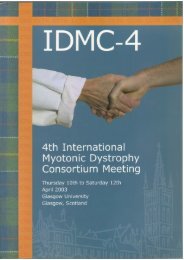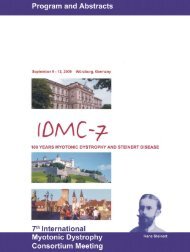Create successful ePaper yourself
Turn your PDF publications into a flip-book with our unique Google optimized e-Paper software.
Abstract No : 30<br />
ORAL PRESENTATIONS<br />
ANALYSIS OF CANDIDATE GENES MODIFIER FOR<br />
THE CONDUCTION SYSTEM IMPAIRMENT IN MYOTONIC<br />
DYSTROPHY TYPE 1 (DM1)<br />
Vallo L., Bonifazi E., Rinaldi F., Contino G., Iraci R., Palladino A., Sannino P.,<br />
Politano L., Botta A. and Novelli G.<br />
Tor Vergata University-Via Montpellier 1,00133 Rome, Italy<br />
Myotonic <strong>dystrophy</strong> type 1 (DM1) commonly includes cardiac involvement that typically occurs<br />
because of myocardial fibrosis. The myocardial fibrosis typically manifests as conduction disturbances,<br />
arrhythmias, ventricular dysfunction and sudden death. Atrio-ventricular block<br />
(AVB) is one of the most frequent conduction alteration in DM1 and it is present in 20 % of<br />
patients at baseline and 50 % at follow up. Mechanisms underlying the phenotypic heterogeneity<br />
of heart involvement in the disease are still unclear. The aim of our study is to analyse<br />
genes that could play a role in the phenotypic outcome of cardiac conduction abnormalities in<br />
DM1 patients. We selected a set of candidate genes on a functional basis : LMNA (lamin A),<br />
NK2.5 (NK2 transcription factor related, locus 5) and PRKAG2 (protein kinase, AMP-activated,<br />
γ2). Our approach consists in an association study of intragenic polymorphic variants<br />
with the AVB phenotype in genetically confirmed DM1 subjects. At this purpose, we recruited<br />
32 DM1 patients showing AVB and 30 patients DM1-positive patients with no cardiac disease.<br />
Genotyping has been performed using a combination of polymerase chain reaction-restriction<br />
fragment length polymorphism (PCR-RFLP) and Taqman® real-time PCR technology. Statistical<br />
analysis did not reveal any significant association of the selected genes with the AVB in DM1.<br />
At present the characterization of other genes and the recruitment of a larger sample of affected<br />
subjects are in progress.<br />
QUEBEC 2005 51




